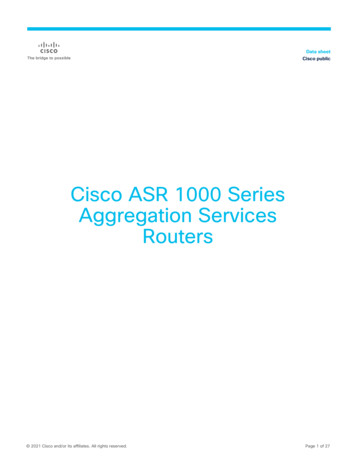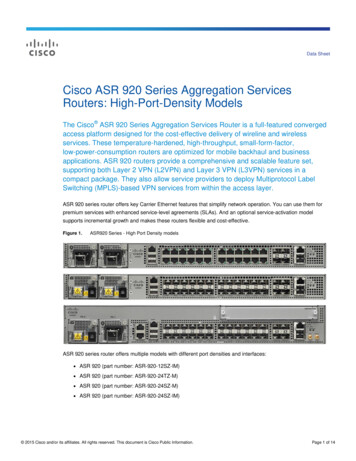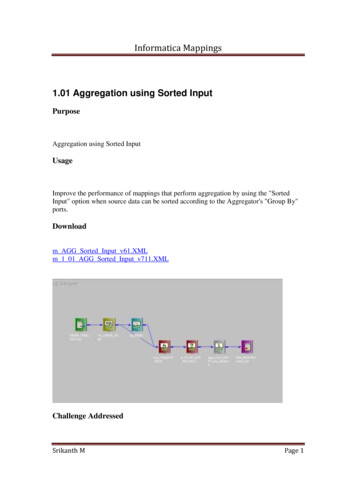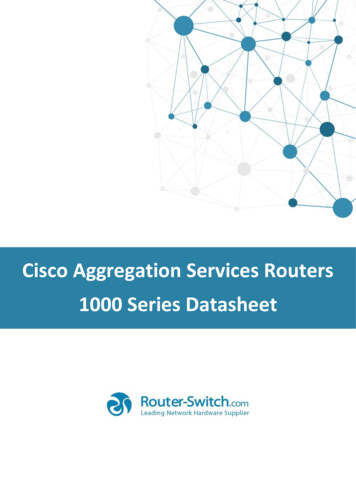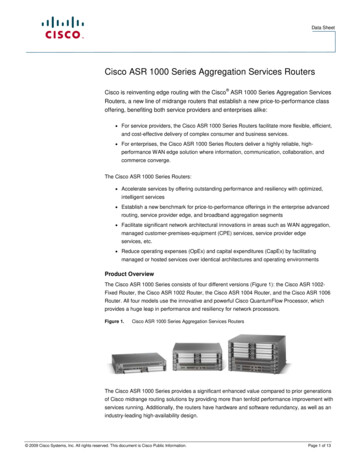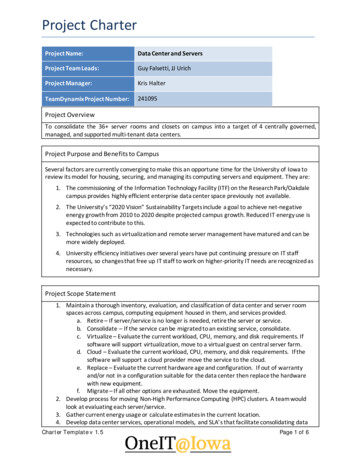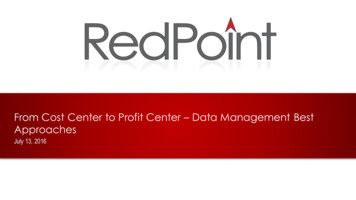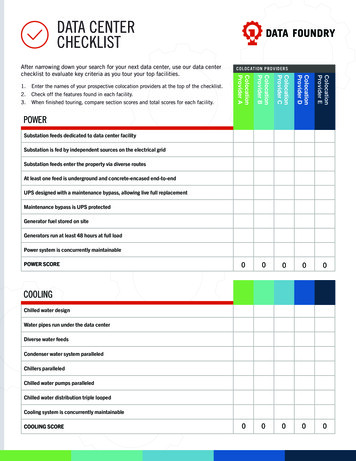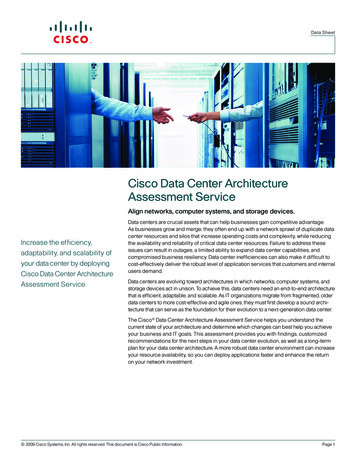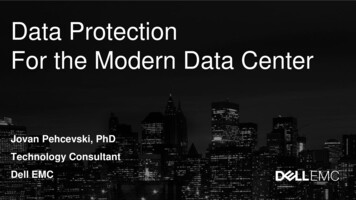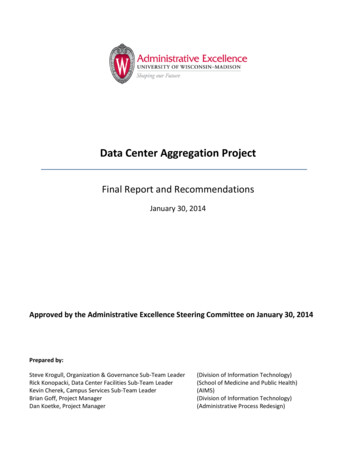
Transcription
Data Center Aggregation ProjectFinal Report and RecommendationsJanuary 30, 2014Approved by the Administrative Excellence Steering Committee on January 30, 2014Prepared by:Steve Krogull, Organization & Governance Sub-Team LeaderRick Konopacki, Data Center Facilities Sub-Team LeaderKevin Cherek, Campus Services Sub-Team LeaderBrian Goff, Project ManagerDan Koetke, Project Manager(Division of Information Technology)(School of Medicine and Public Health)(AIMS)(Division of Information Technology)(Administrative Process Redesign)
Data Center Aggregation ProjectFINAL REPORT AND RECOMMENDATIONSNotes on Revisions to the Final Report and RecommendationsAn Initial Draft Final Report and Recommendations was shared and discussed with the Steering Committee onOctober 22, 2013.A Second Draft Final Report and Recommendations was shared and discussed with the Steering Committee onDecember 18, 2013. This version included the following edits suggested by members of the AE Data CenterAggregation Organization / Governance Sub-Team during their final meeting on December 2nd and additionalcorrespondence through December 13th: Delivery of Services and the Customer Engagement Process (section added to page 15) Campus Readiness (edits to the disincentives section on page 22)The Final Report and Recommendations includes additional content which the Steering Committeeasked the Executive Committee and Organization / Governance Sub-Team Leader to provide. Inaddition to feedback received from the Madison Technology Advisory Group (MTAG) on December17th, the following additional content was shared and discussed with the Steering Committee onDecember 18th: Data Center Aggregation Implementation Team – Change Management Plan (page 23) Engagement Framework for Potential Data Center Aggregation Sites (page 26) Central Data Center Service Operational Plan (page 30) Power Metering Plan for Distributed Data Centers (page 32) In January 2014, members of the Executive Committee and the Organization / Governance Sub-TeamLeader refined the proposed structure of the Campus-Level Data Center Services Unit to one in which theCIO’s strategic vision is operationalized within the DoIT organization while still retaining accountability tothe CIO in a dotted-line fashion. It should be noted that the refined structure found in Appendix 9 (page49) includes edits that were completed after the December 18th meeting with the Steering Committee.This revision was approved by the Steering Committee on January 30, 2014.Page 2 of 50Report Date: January 27, 2014
Data Center Aggregation ProjectFINAL REPORT AND RECOMMENDATIONSTable of ContentsSectionPageExecutive Summary4Project Background7The UW-Madison Data Center Landscape (Current State)10 Data Center Services – Facilities Assessment10 Data Center Services – Campus Needs Assessment11Findings and Recommendations11Proposed Campus-Level Data Center Services Unit14 Description14 Value Proposition to Campus16 Delivery of Services and the Customer Engagement Process18 Data Center Assessment Process21Campus Readiness24 Summary of Known Obstacles to Central Service Adoption24 Incentives and Disincentives24 Change Management Plan27 Engagement Framework for Potential Data Center Aggregation Sites30Operational Roadmaps32 Central Data Center Service Operational Plan34 Power Metering Plan for Distributed Data Centers36 Next Steps36AppendicesOne:Data Center Aggregation Implementation Team Structure38Two:Proposed Minimum Standards for Campus Data Centers39Three:UW-Madison Data Center Facilities Inventory40Four:Alternative Data Center Solutions Considered42Five:Standard Data Center Cost Model: Example44Six:Minimum Service Requirements for Campus-Level Data Centers45Seven:Campus Communications / Socialization Activities48Eight:Labor Estimates – Campus-Level Data Center Services Unit49Nine:Campus-Level Data Center Services Unit Structure (refined Jan 2014)50Page 3 of 50Report Date: January 27, 2014
Data Center Aggregation ProjectFINAL REPORT AND RECOMMENDATIONSExecutive SummarySteering CommitteeExecutive CommitteeSub-Team LeadersProject ManagersPaul DeLuca, Darrell BazzellAlice Gustafson, John Krogman, Bruce Maas, Ed Van GemertSteve Krogull, Rick Konopacki, Kevin Cherek, Terry BradshawBrian Goff, Dan KoetkeProject Goal (articulated by the Phase II team): Develop a new model of server and data center structure to servethe needs of the University’s academic, research, and administrative communities, leveraging industry-leadingpractices for server administration, virtualization, and management to save costs, improve service levels, andminimize data security risks. During the September 2013 update meeting, the Steering Committee expressedinterest in eventually reducing the number of campus data centers from its current number to two.Solution Summary: This team’s final report describes a proposed Central Data Center Service that offers andmanages a portfolio of data center solutions that will serve the vast majority of campus customers. This portfolioincludes co-located facilities, virtualized solutions, and a small number of physical facilities here on campus. Thebenefits to the University will be improved services and data stewardship practices, risk reduction, expenditureavoidance, utility savings, reduced staff time and maintenance costs, and improved space utilization. Due to theramp-up costs associated with building capacity and funding campus utilization incentives, the proposedimplementation may not result in a net cost savings for at least five years.Aggregation Roadmap: The Central Data Center Service will drive the university toward a small number of aggregated datacenters, with success measured as a reduced number of decentralized data centers and the total squarefootage they collectively occupy. The Central Data Center Service will track and report on cost savings realized over time. Areas of costsavings include expenditure avoidance, utility savings, reduced staff time, reduced maintenance costs,and improved space utilization. During the first two years, the Central Service will focus on ramping up capacity, virtualizationinfrastructure, and service capability to prepare for an increased migration volume. By the third year, the Central Service will be well positioned to accelerate campus adoption and will havehad experience with pilot engagements and incentive strategies. By utilizing off-campus solutions and more efficient hardware on campus, the number of data centers tobe managed centrally under a single portfolio is likely to max out at eight, and total central FTE requiredwill likely level off at 30. In order to drive down both the of distributed data centers and the total square footage utilized bydistributed data centers, campus engagements during and after the third year forward will focus on abalanced mix of large and small data centers. In order to be successful, this implementation will require significant central financial support. This islikely to be in the range of 1- 2 million per year for the first five years as the Central Service ramps up itscapability, followed by a tapered reduction in the level of central support needed.Proposed Process for Assessing Distributed Data Centers: The team developed a systematic and objective datacenter assessment process for engaging and evaluating potential aggregation partners. The work product of eachPage 4 of 50Report Date: January 27, 2014
Data Center Aggregation ProjectFINAL REPORT AND RECOMMENDATIONSassessment will be brief decision document for each unit’s technical and business leadership (e.g., Dean and CIO).This document will include the following the following elements: Facilities Assessment – evaluates a unit’s facility against the set of minimum specification requirements;team’s research shows that very few data centers on campus will meet these, and mitigation tends to beprohibitively costly Risk Assessment – identify known data, environmental, and other risks; many very significant risks will beunknown Services Assessment – identifies services delivered by a unit’s data center Cost Assessmento The team created a standardized cost model to serve as an easy-to-understand foundation for afully-burdened cost model, enabling apples to apples comparisons of all costs related to campusdata centers.o Captures costs to individual campus units as well as those paid at the University level such aspower and cooling utilities.o The team has found it prohibitively difficult to gather cost information from units in astandardized format because these costs are typically not managed in any way other thanhardware & software purchases. Decision Pointo Key aggregation drivers will be the need for risk mitigation and ensuring minimum facilitiesstandards are met, not a reduction in overall operating costso In the majority of cases, the objective answer will be to utilize the Central ServiceProposed Campus-Level Data Center Services Unit: Will serve as the primary business unit for the campus data centers. The campus data centers will have unified facilities management, shared and common support staff,integrated services across the campus facilities, a common client engagement and support model, a singlefinancial model, and accountability through the CIO office. The team recommends direct accountability to the CIO through an explicit change in organizationalstructure. The Executive Committee refined the proposed structure to one in which the CIO’s strategicvision can be operationalized within the DoIT organization while still retaining accountability to the CIO ina dotted-line fashion.Funding the Central Services Unit & Campus Incentives: To keep the price of utilizing the Central Service below market alternatives, campus customer pricingshould be based on their consumption only, not the cost of maintaining infrastructure. While non-financial incentives will be important drivers of campus adoption (summarized in the CustomerReadiness section of this report) financial incentives will be particularly important for two reasons:o Potential campus customers indicated that price is their number one decision drivero At some point in the future, possible financial disincentives may help fund the Central Service This price reduction will result in a very significant reduction in revenue that needs to be replaced byother funding sources:o Once utility metering is in place, shift utility costs currently paid by the University to campus unito Actual utility cost reduction, regardless of funding sourceo “Common good” central fundingo Labor costs (difficult to assess, but it is recognized that over time and across campus, we will seeproductivity gains)Page 5 of 50Report Date: January 27, 2014
Data Center Aggregation ProjectFINAL REPORT AND RECOMMENDATIONSImmediate Next Steps: Over the next 2-3 months, continue to develop the funding and staffing model of the Central Services Unitsuch that the availability of a new campus service can be communicated to campus in January 2014. Continue to engage campus Governance, functional groups, and other stakeholders as outlined in theCommunication / Socialization Plan.Page 6 of 50Report Date: January 27, 2014
Data Center Aggregation ProjectFINAL REPORT AND RECOMMENDATIONSProject BackgroundIntroduction:UW-Madison operates many campus data centers, server rooms dedicated to maintaining local informationsystems. An Administrative Excellence team was created to assess the current state of these centers, adoptindustry standards for security, power and backup and consider ways to aggregate centers providing redundantservices. The aim is to improve efficiency, reduce costs and provide affordable, streamlined assistance for thecampus.Chartered Project Goal:Develop a new model of server and data center structure to serve the needs of the University’s academic,research, and administrative communities, leveraging industry-leading practices for server administration,virtualization, and management to save costs, improve service levels, and minimize data security risks.The following is a visual representation of the current and future state:In March of 2012, a cross-campus team surveyed data center administrators and identified opportunities forefficiencies via an aggregated data center model. For all of the details on the team’s findings andrecommendations, please review the full business case for the AE Data Center Aggregation Project Phase II. Thebusiness case may be found in the “Projects” section of the Administrative Excellence web /it-data-center-aggregation/).Launch of the Data Center Aggregation Implementation Team (Phase III):In October 2012 an implementation team was launched, comprised of the following three project sub-teams, eachcharged with completing deliverables in one of three functional areas:Page 7 of 50Report Date: January 27, 2014
Data Center Aggregation ProjectFINAL REPORT AND RECOMMENDATIONS1.Campus Services Sub-TeamThe primary goal of the campus services sub-team was to identify the set of baseline service requirements servicelevels that a campus-level data center service should provide. The scope of these baseline service requirementsincluded both physical and virtual data center needs and preferences and the service attributes of suitable hostingfacilities, both on campus and off campus. The scope of their work explicitly excluded areas such as cost andpricing models, specific methods for the provision of services and other aspects addressed within other areas ofthe AE Data Center Aggregation implementation project.The process used by the sub-team focused on collecting, understanding, and documenting the “voice of thecustomer” to ensure that new service offerings will meet the critical needs and preferences of campus. Toaccomplish this goal the team: Reviewed the outcomes of the Data Center Aggregation Focus Group held by the Phase II AdministrativeExcellence team in summer 2012 and then identified the appropriate areas for data collection.Developed an interview template to guide conversations through relevant topics such as data storage,networking, security, remote access, and availability. Interview participants were selected from a crosssection of campus customers and stakeholders. Interviewees included a broad range of data centerservice customers and their providers.Analyzed trends in interview responses and segmented these into logical service categories and relatedservice attributes. Once organized, the team distilled minimum requirements within each service category(and also often within specific service attributes). The sub-team also captured and (separately)documented service requirements above and beyond the baseline service levels.2.Data Center Facility Inventory Sub-TeamThe primary goal of the facilities sub-team was to develop and refine an inventory of all UW-Madison facilities,both on and off campus, that qualify as operating as “campus data centers.” Qualification involved meetingcertain key attributes as defined by the team, including: Physical sizePower capacityCooling capacityEnergy efficiencyPhysical securityEnvironmental monitoringThe inventory began with collecting data through two campus surveys sent to data center administrators andcampus building managers. This data was refined and then converted to a searchable database. The next stepinvolved contacting all administrators of data centers larger than 200 square feet and scheduling on-site visits andinterviews to get as much accurate data as possible about the facility.The facilities team developed recommended minimum standards for data center installations on campus andtransitioned these to the Organization and Governance sub-team. Those who will continue to forward the work ofthe overall initiative may develop some additional levels of data centers akin to the Uptime Institute’s data centertier levels, but more useful for the needs of UW-Madison.Page 8 of 50Report Date: January 27, 2014
Data Center Aggregation ProjectFINAL REPORT AND RECOMMENDATIONSThe team also investigated and considered several alternative models to determine facilities operations costs,such as cooling, power use and physical infrastructure which contributed to the recommended standardized datacenter cost model.3.Organization and Governance Sub-TeamThe primary charge of this sub-team was to integrate the findings of the Facilities and Campus Services sub-teamsto define, develop, and ultimately deliver a scalable campus-wide data center services offering, including a multiyear operational plan for realizing the cost savings associated with increasing campus adoption of the centralizedservice.Below is a visual representation of how the work of the three sub-teams fit within the overall project:Page 9 of 50Report Date: January 27, 2014
Data Center Aggregation ProjectFINAL REPORT AND RECOMMENDATIONSThe UW-Madison Data Center Landscape (Current State)Current State Summary:The opportunity exists today to encourage best data center practices using incentives that will result in costsavings for central campus, individual schools, colleges, and administrative units through the reorganization andconsolidation of server placements and solutions including increased virtualization, aggregation, and outsourcing.While the primary driver of this project was to be able to recover cost savings from co-location and virtualization,the team found that the greatest benefits to the University as well as decentralized campus units lie in other areassuch as providing safe, secure storage for sensitive data. There exists an increasing need to safely store data, andthe current server/data center environment puts the institution at risk for data loss and the resulting financial andreputational costs.The University is dependent on a wide range of IT resources to carry out its mission of teaching and research, andthe proposal outlined in this report provides an operational strategy this will continually inventory and assess thefitness of the existing infrastructure in support of that mission and recommend changes as needed.Data Center Services – Facilities Assessment:There are a multitude of server rooms across campus, providing a wide range of hosting services. The teamidentified 97 facilities through its March 2012 survey of data center administrators and validation work completedin spring of 2013. Approximately 52,000 sq. ft. of identified hosting space; approximately 55 percent used for researchpurposes60 percent of facilities host virtualized servers25 percent of facilities are 500 square feet or larger; 16 percent are 100 square feet or smaller50 percent of facilities cannot freely share their facilities with others due to restrictions on how theirfunding can be used or particular security policies they must follow53 percent have lockable racks; 34 percent have card access systems76 percent of facilities have a dedicated cooling system; 30 percent have a backup cooling systemThe current primary driver for developing server room space leans towards expediency and convenience withlittle emphasis on reliability, energy efficiency, or security. The result is that most of these data centers are notmanaged according to industry norms and are inefficient. None are managed as a campus resource. Some aren’tproperly sized. Almost all were designed before the advent of virtual computing.For some departments with access to facilities and services, recent virtualization efforts have reduced the needfor expansion into additional spaces. Meanwhile, other departments who need server room services but don’thave access to them must beg, borrow, or lease space, or hope that their department has enough money tomodify an existing space appropriately. Ultimately, to minimize cost and space, some end up utilizing sub-optimalspaces for server hosting. While the biggest return on investment is in encouraging the virtualiz
Jan 30, 2014 · The UW-Madison Data Center Landscape (Current State) 10 Data Center Services – Facilities Assessment 10 Data Center Services – Campus Needs Assessment 11 Findings and Recommendations 11 Proposed Campus-Level Data Center Services Unit 14 Description 14 Value Proposition to Campus 16
